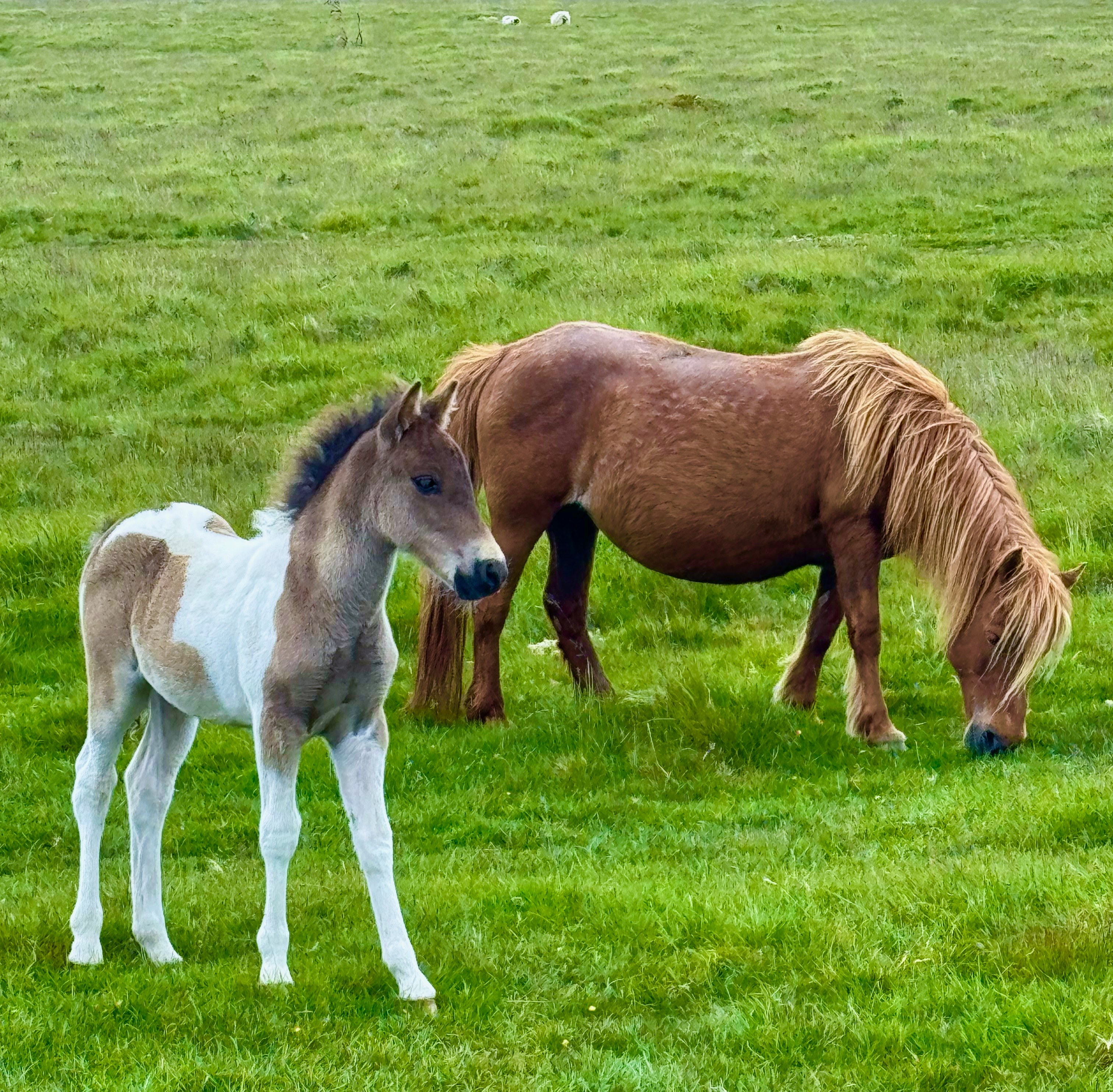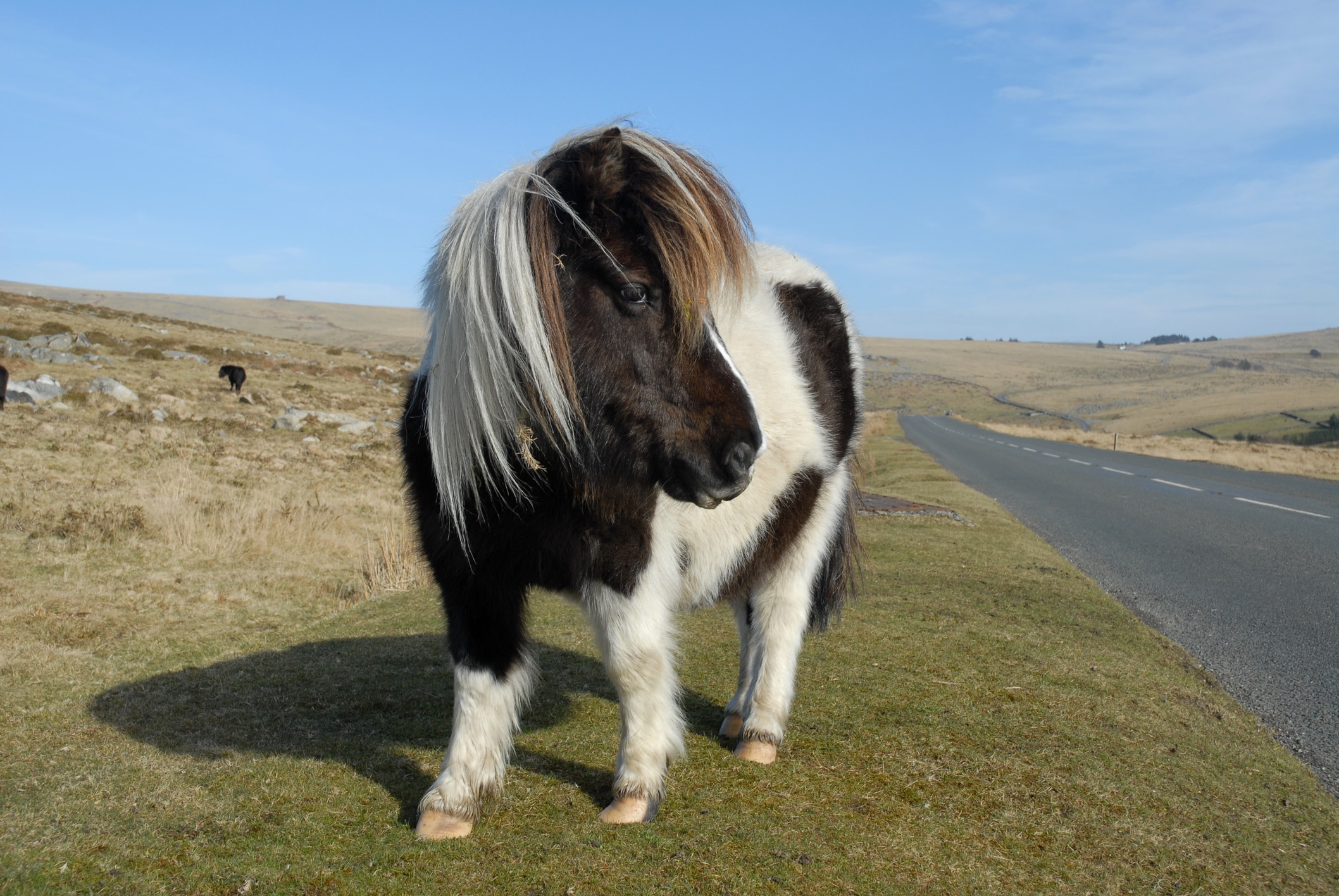Dartmoor Pony
Josie Elias/iStock / Getty Images Plus via Getty Images
The Dartmoor Pony is a rare horse breed native to Devon, England. You can see these semi-wild ponies on Dartmoor, where they’ve lived on the moor for centuries.
Dartmoor Ponies are also kept as pets because of their temperament and capabilities—they make great equine companions for children and can be used for work, show, and riding.
Dartmoor Pony Snapshot
-
Height: Up to 12.2 hands (48.8 inches)
-
Weight: 450 to 500 pounds
-
Lifespan: 25 to 30 years
-
Colors: Brown, bay, black, chestnut, roan, gray. Some white markings are allowed.
Caring for a Dartmoor Pony
Caring for a Dartmoor Pony isn’t particularly difficult. They are friendly, docile ponies who don’t have complicated grooming needs and can be trained for riding, work, competition, and show. Also, they are hardy and can do well in a cold climate.
However, Dartmoor Ponies can gain weight easily and develop medical problems as a result, so pay careful attention to their diet and activity level.

Dartmoor Pony Health Issues
The Dartmoor Pony is a generally healthy breed. While the wild ponies on Dartmoor are susceptible to contagious infections due to not being exposed or vaccinated for common infectious diseases like our domesticated horses are, those kept as pets could develop some of the health problems that various other horse breeds are also prone to, including:
Equine Metabolic Syndrome (EMS)
Dartmoor Ponies tend to have a high incidence of equine metabolic syndrome (EMS), which causes the body to have difficulty regulating insulin. Horses that are overweight are at risk of EMS, so ensure your Dartmoor maintains a healthy body condition score. It’s also important to tackle this problem before it can lead to laminitis.
Symptoms of equine metabolic syndrome include obesity and fatty deposits on the neck, tailhead, and ribs. A veterinarian can diagnose this condition with blood work and recommend a treatment plan, which may include dietary changes to manage calories and carbohydrate intake. You may also need to reduce your pony’s access to pasture.
Although there is no cure, EMS can be managed with diet and exercise under a veterinarian’s guidance.
Pituitary Pars Intermedia Dysfunction (PPID)
Pituitary pars intermedia dysfunction (PPID), or Cushing’s disease, is a progressive endocrine disorder that disrupts hormone production from the hypothalamus (region in the brain) and impacts the pituitary gland.
Symptoms of PPID include:
-
Long or curly coat
-
Patchy shedding of winter coat
-
Excessive sweating
-
Muscle loss
-
Lethargy
-
Pot-bellied appearance
-
Increased drinking and urination
-
Chronic infections
-
Laminitis
A veterinarian can diagnose this condition and provide medications and dietary recommendations for managing it.
Laminitis
Also known as founder, laminitis in horses can be acute or chronic. It occurs when the laminae, which attach the coffin bone to the hoof wall in a horse’s hoof, become inflamed and damaged.
Symptoms include lameness, pain, and changes in the horse’s posture. With chronic laminitis, there may be changes in the hoof’s appearance, such as ridges, white line disease, abscess, and coffin bone displacement.
Causes for laminitis in horses include injuries and other health problems, such as EMS and PPID. Obesity can also boost a horse’s risk, so feeding your Dartmoor Pony properly is critical. By ensuring they don’t eat too many sugars, starches, and grains, and by restricting access to lush pasture, you can help prevent this condition.
Laminitis is painful and requires immediate veterinary treatment because it can lead to permanent damage. In some cases in horses with severe or chronic laminitis, humane euthanasia may be the only option.
Obesity
Because Dartmoors are easy keepers, they can gain weight quickly. Your veterinarian can provide guidance on what to feed your horse, as well as how much to feed them, to maintain a healthy weight and body condition.
If your pony is overweight or obese, your veterinarian can also provide tips on how to help your pet lose weight safely.
What To Feed a Dartmoor Pony
Feeding your Dartmoor pony a good-quality diet is extremely important to maintaining good health. Generally their diet should consist of a good forage or pasture, along with a grain of some type depending on their age, lifestyle, and energy requirement. Because they are generally easy keepers, feeding lower-starch feeds is usually ideal.
Make sure you don’t overfeed your pony. You can use a grazing muzzle or slow feeder to prevent them from overeating or eating too quickly. Eating slowly can also help to reduce the risk of stomach ulcers and colic.
To figure out how much to feed your Dartmoor Pony, start by calculating 2% of their body weight, then feed them that amount in forage each day. For example, if your pony weighs 475 pounds, they would need 9.5 pounds of hay daily.
Grass hays low in starch and sugar such as timothy or orchard grass may be an ideal choice for Dartmoor Ponies. Your veterinarian may also recommend adding a nutritional supplement to their diet. For example, nutritional supplements may be ideal for senior horses and ponies that are active.
Dartmoor Pony Disciplines
Dartmoor Ponies were used as work horses in the past, but they are better known today for their companionship.
The Dartmoor Pony is a fantastic choice for children, whether you are getting your child their first equine companion or if they are already experienced riders. These ponies can even be ridden by small-sized adults.
Dartmoor Ponies also do well in competitions and shows. They excel in driving and jumping in particular.
Dartmoor Pony Personality and Temperament
There’s a lot to like about the Dartmoor Pony. Of course, each horse is an individual with a unique personality, but these ponies are usually described as gentle, calm, friendly, reliable, and intelligent. Therefore, they are a great match for young and novice riders, including those who are a bit nervous about being on a horse for the first time.
These energetic ponies like to be active and are willing to learn and work. They will bond with their caretakers and riders. And with proper training and handling, they will be docile and follow your commands.

Dartmoor Pony Training
Without training, a pony might exhibit unwanted behaviors like nipping, kicking, and being reluctant to work. If any behavioral issues arise, make sure your pony isn’t bored, in pain, or sick.
Spend time with your pony and get to know them and their quirks. That way, they will feel completely at ease with you and you’ll begin to understand their preferences and needs.
Be patient as you teach them commands, and use gentle, positive training techniques. Never use aggression to train your Dartmoor Pony, as that will only cause them to become stressed and fearful of you.
Dartmoor Pony Grooming Guide
The Dartmoor Pony has a beautiful, thick coat, with a full mane and tail. Grooming them regularly will ensure their coat remains clean and smooth and their mane and tail will be tangle-free. Plus, grooming sessions are a lovely way to bond with your pony, as they’re sure to love the attention.
The Dartmoor Pony doesn’t have complicated grooming needs. A basic equine grooming kit should be enough to do what’s necessary to keep your horse’s skin and coat healthy.
Coat Care
If you can’t brush your Dartmoor Pony daily, aim to groom them a few times a week. Use this time to look for symptoms that need veterinary attention, such as signs of irritation, infection, injury, or inflammation.
Because a Dartmoor Pony’s coat will be thicker in the winter and will shed in the spring, you will likely spend more time grooming them during those seasons.
Using tools like a curry comb, dandy brush, shedding blade, and finishing brush will allow you to quickly and easily remove dirt and debris from throughout your pony’s coat. A mane and tail brush can be used specifically on those areas to ensure they aren’t pulled or damaged.
Hoof Care
Cleaning your Dartmoor Pony’s hooves with a high-quality hoof pick should be done daily. This important step removes debris from the hooves, and it’s another opportunity to check on your horse and make sure they aren’t developing any symptoms of disease or injury.
Work with a qualified farrier to give your pony the hoof care they need, including trimming of hooves and application of shoes that provide protection if needed.
Dartmoor Pony FAQs
Are Dartmoor Ponies wild?
The ponies on Dartmoor today are semi-wild—they aren’t totally wild because they are owned by farmers. They live in Dartmoor National Park in England, and visitors can see them roaming freely.
Can Dartmoor Ponies be ridden?
Although they are small (around 48 inches tall), Dartmoor Ponies are strong and can be ridden by children and small-sized adults.
What are Dartmoor Ponies known for?
Dartmoor Ponies are known for their long history living on the moor in Devon in southwest England. Experts believe that they’ve thrived there for 4,000 years, and records of these horses date back to 1012 CE. Because of their life in a harsh climate, they are hardy ponies, and their temperament makes them ideal for children who enjoy riding and equestrian sports.
